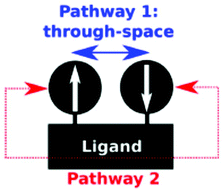Synthesis, characterization and magnetic properties of head-to-head stacked vanadocenes†
Abstract
In order to design magnetically active molecular materials, it is desirable to arrange paramagnetic molecules in one dimension, which may lead to a molecular bar magnet. For this purpose, vanadocenyl units with three unpaired electrons each can be stacked in a head-to-head fashion. The target compound in this work is 1,8-bisvanadocenyl naphthalene, where the naphthalene backbone serves as a clamp keeping two vanadocene units together. The target compound in this work is obtained through the reaction of the disodium salt of 1,8-biscyclopentadiendiylnaphthalene with the cyclopentadienyl vanadium (CpV) transfer reagent [V(μ2-Cl)(η5-Cp)(thf)]2. The 1,8-bisvanadocenyl naphthalene is fully characterized. In addition, variable temperature 1H NMR spectroscopy, X-ray structure analysis, magnetic measurements and DFT calculations have been performed. In both experiment and theory, a weak antiferromagnetic coupling between the spin centers is found, with the spin highly localized on the V(II) ions.



 Please wait while we load your content...
Please wait while we load your content...